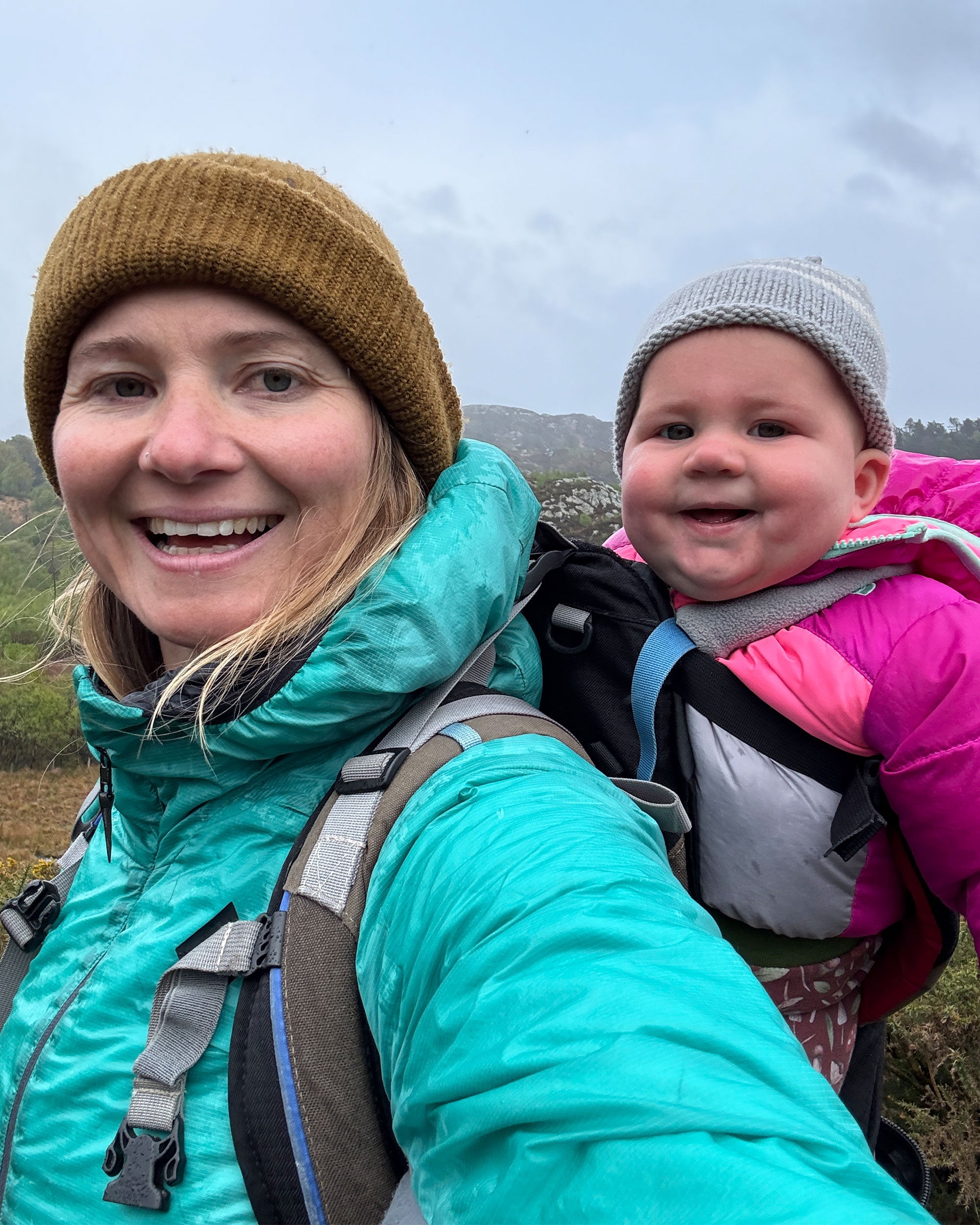FACING THE FEAR
Postpartum recovery was one of my biggest fears going into motherhood. I’ve had plenty of injuries throughout my climbing career—a combination of hypermobility and not always getting the right help early enough—and deep down, I often hold the belief that my body isn’t naturally very resilient. I’d heard horror stories: women whose cores were destroyed, hips misaligned, leaking pee years after giving birth. I was also terrified of having a C-section—the idea of being cut open and left with a huge scar terrified me. A few friends had recovered well from C-sections and even climbed hard again, but most of the “lady crusher” stories I knew were from vaginal births. I worried that a C-section would make it even harder for me to get back to climbing.
Despite preparing well for birth and feeling confident, I still ended up with an emergency C-section. At the time, I felt positive—the hospital team were amazing, and meeting my daughter made it all feel worth it. But when we got home, the hormones crashed, the anesthetic wore off, and I started to panic. Had I destroyed my body? When would I be able to enjoy climbing again?
TWO NARRATIVES, NEITHER ONE QUITE RIGHT
In postpartum spaces, there are two dominant narratives:
• The rest-and-bond one:
Where you lie low, soak up the oxytocin, stay close to your baby, and let your body heal. This is often called the fourth trimester, seen as a continuation of the pregnancy and the matrescence (the becoming of a mother) process. It’s a rebellion against societal pressure to "get your body back" or "bounce back" after birth.
• The bounce-back narrative
Where you’re expected to return to your old body, reclaim your identity, and prove that motherhood hasn’t changed you. This was the dominant expectation until quite recently.
But then I had Aliette — and quite quickly, I realized this approach wasn't going to cut it for me.
For many reasons, I resonated with the rest-and-bond narrative. It felt like a big "eff you" to the impossible standards placed on women, and a much-needed recognition of how impactful birth is on the body. I leaned into the idea of slowing down, bonding with my baby, and softening into a new version of myself and my body.
"But then I had Aliette — and quite quickly, I realized this approach wasn't going to cut it for me."
I wanted to get back to climbing. Not out of fear, not out of pressure, but because it's something I love and always want to be central to my life. Towards the end of pregnancy, I was still climbing, but it wasn’t the same. I wanted to move again in a way that felt like me.
Secondly, birth is like any other physical trauma: it requires active recovery. There is no "snapping back" — and it’s not something you can simply rest your way through either. You have to rehabilitate. And rehabilitation requires both rest and effort. So I found myself striking a balance between these two narratives. It wasn’t all about rest. It wasn’t all about bouncing back either.
HEALING TAKES WORK
The first days were brutal. I couldn’t get off the sofa unaided. Breastfeeding was painful. My partner set up a rope in the bed so I could pull myself up in the night to feed our daughter. A week after birth, even walking a few hundred meters felt overwhelming. My core felt like soup. Hanging on a bar, let alone pulling up on one, felt unimaginable. My first exercise from my postpartum trainer, Joy Black, was simply lifting my arm up and down — a lat pulldown with no resistance. Working with Joy was absolutely key — not just for getting back to climbing, but for building a foundation for long-term health and confidence. Breathwork, as during pregnancy, became my foundation again. Breathing exercises helped my core reconnect. I started with the smallest, most gentle movements. And slowly, I began to rebuild.
Around a month postpartum, I did my first hang from a bar. At six weeks postpartum, I was bouldering again — surprisingly on a slightly overhanging wall. The progress arc was incredible — when else do you get to climb a harder grade every week? At four and a half months postpartum, I climbed V9 in Albarracín. For context, my hardest boulder grade is V11. I was proud — but even more than that, I was so psyched. Not for the grade, but because on this problem, I really felt like myself again. Because I had climbing properly back in my life. I still have a long way to go: My core is still weak, my power is down, my overall fitness is low, and
breastfeeding hormones have made it hard to regain muscle mass
"...But I’m getting there — slowly but surely."
A FEW PRACTICAL TOOLS THAT HELPED:
• Working with a postpartum physio or rehab specialist (like Joy Black)
• Breath-focused exercises (diaphragmaticbreathing, 360 breathing)
• Core reconnecting movements (early-stage Pilates, functional strength work)
• Mindfulness practices (short meditations, body scans to manage stress and regulate the nervous system)
MY NEW IDENTITY
Just like recovery, identity after motherhood comes with two dominant narratives. Before having a baby, I saw myself as someone who would hold onto her identity — someone who would carve out space for her work and passions, who wouldn’t martyr herself endlessly for her family. And in some ways, I have.
But I’ve also understood the pull of the other story — the story where you give yourself entirely to your baby. Where you don't want to miss a thing. Where you realize that your love for climbing is powerful, but it’s nothing compared to what you feel for this tiny being who can’t even talk yet.
These narratives don’t account for the messy middle. They don’t account for the real-life pressures — work, family, friendships, recovery, childcare (or the lack of it). They don’t account for how hard it is to do everything you did before, while looking after a baby. They don’t account for what motherhood does to your brain — or how much your child uniquely needs you as their mother, even when your partner is brilliant and supportive.
Every parent knows the feeling of doing it all badly. Of feeling like a bad parent because you want to climb. Of feeling like a bad climber because you have a kid.
And I have totally felt like that, but I’ve tried to flip the script and think of it in terms of how lucky I am that I get to fill my life with things I love, even if juggling those things feels impossible at times. How beautiful is it that I get to take my baby to the boulders, even if she distracts me while I climb? Everything annoying about my child is also something to cherish.
Some behavioral psychology studies show that parents report being less happy after having kids. But in my opinion, those studies miss the point. They ask about happiness in the moment. What they don’t capture is that true happiness is meaning. Motherhood has given my life new meaning. Climbing has always given me meaning too. And I am so grateful I get to experience both.
TIPS FOR LIVING IN THE GREY
Here’s what’s helped me navigate this messy, beautiful, frustrating journey:
1. Healing requires rehab, not just rest. Rest, but also take your recovery seriously. Prioritize it. Respect your body's timeline.
2. Climb for joy. You already have enough pressure. Let climbing be a source of fun, freedom, and lightness — not another performance metric. Ironically, it will probably help your performance in the long run.
3. Redefine progress. Some weeks, progress is a new grade. Other weeks, it’s five minutes of core work while the baby naps. Celebrate it all.
4. Feel the guilt — and listen to it. Not all mum guilt is irrational. Sometimes it’s intuition. If you feel like you're missing something important, pause and check in. Maybe your baby needs more of you — or maybe you need more of them.
5. Let yourself recalibrate. You won’t always get the balance right. That’s OK. Notice, adjust, forgive yourself.
6. Accept that your climbing life might look different — For a while or forever. It doesn’t make you less of a climber. It might even deepen your relationship with the sport.
7. Work towards a mindset of sufficiency and abundance. You can love your baby and your sport. You can thrive and be exhausted at the same time. You’re allowed to be powerful, soft, tired, motivated, overwhelmed, and inspired — all at once.
"You don’t have to choose a camp — the restful, present mother or the resilient, identity-holding mother. The truth is, most of us are somewhere in the middle, trying to figure it out one day at a time."
AN INVITATION
To the mums who are climbing again — slowly, joyfully, uncertainly — I see you. If you’re not bouncing back, and you’re not opting out, but you’re somewhere in the grey, know that you are not alone. This middle space is real. It’s messy. It’s powerful. You’re a climber and a mum — and you’re brilliant at both, even if it doesn’t always feel like it.

About the author
Hazel Findlay is a professional climber and mindset/mental training coach. She’s known for her bold ascents and her work helping climbers develop psychological skills for resilience, motivation, and self-trust. As a new mum, Hazel continues to explore the complex relationship between adventure, identity, and personal growth.

